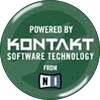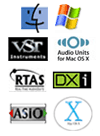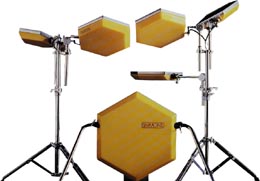|
Nostalgia demo 1
Nostalgia demo 2


|
 |
The Simmons SDS5 (or SDSV
as it is was officially known) was the world's first truly electronic
drum kit.
Prior to the Simmons, there had been electronic drum
pad synths such as the Pearl Syncussion and the Electro-Harmonix
'Space Drum' but these were pretty much nasty 'byoo byoo' gimmick
boxes that were essentially a sound effect adjunct to an acoustic
drum kit or percussion rig and much beloved of certain naff disco
tracks |
Dave Simmons had an altogether different
vision... to make drum synthesis 'serious' and expressive.... a
viable alternative to 'acoustic' drums.
Working with Richard Burgess (then the drummer with the
jazz/pop fusion band Landscape and probably most famous for their
hit single 'Einstein a go-go' and now a respected producer), Simmons
devised a unique drum synthesiser that put the individual components
of a drum sound under users' control.
Typically, a drum sound consists of two elements - a
pitched tone and unpitched noise. Using discrete analogue circuits,
Simmons devised a series of modules optimised to produce certain
drum sounds such as kick, snare and toms that could be triggered
from pads. Each module contained a variable triangle wave oscillator
and a noise generator which could be mixed and manipulated to provide
a wide range of drum and percussion sounds as well as special effects.
The thing was a hit almost as soon as it was released
in 1982. It sounded great, it sounded unique and it sounded distinctive
- it even came with four presets for each module so even those with
no experience could coax something decent out of it.
A standard SDSV came shipped with 5 modules - kick, snare
and three toms. On the surface, these looked pretty much identical
with controls for noise level, tone level, bend, decay time, noise
tone (a simple, static filter) and the curiously labelled 'click
drum' control which added extra attack derived from pad velocity.
However, despite the similarities, each module's parameter range
was optimised for the sound it was designed to re-create. Simmons
subsequently added hi-hat and cymbal modules but these were unconvincing
and generally, most drummers still retained acoustic hats and cymbals.
It was also an altogether 'pro' unit with balanced XLRs
everywhere. You could even run it from a drum machine such as the
TR808 or a multi-channel sequencer such as the Roland MC4b Micro-Composer.
In my experience, however, triggering the modules in this way did
not produce such a good sound as much of the SDSV's sonic presence
was derived from the inocuous 'click drum' control. |
|
But Simmons had another trump
up their sleeve.... their cosmetic styling.
At a time when image was everything (remember... this
was the early '80s - new romantics, Duran Duran, Spandau Ballet,
et al), the Simmons kit's striking hexagonal pads just
looked fabulous on stage and in videos on the emerging MTV.
But whilst the pads looked suitably 'hi-tech' and 'space
age' to casual punters, drummers were less than impressed. The 'skins'
for these pads (i.e. the bits you actually hit) were made from the
same (hard) material that was apparently used in shields issued
to riot police! From the manufacturer's point of view, this was
perfect.... a robust construction that would take a good beating. |
 |
From a drummer's point of view, however,
it was a recipe for severe wrist-ache!
Subsequent variations/improvements on the SDS theme introduced
rubber pads that were easier to play and kinder on drummers' wrists!
However, with these new pads came revisions to the 'brain' of the
system (i.e. the electronics that actually produced the sound) and
many will claim that later revisions of the product lacked the true
character of the original SDSV.
The first of these was the SDS7, a curious analogue/digital
hybrid that also included sampled sounds on a EEPROM chip. Users
could have their own chips 'blown' by sending recordings of their
favourite drums to Simmons - by purchasing an EEPROM blower, they
could make their own. The SDS7 was prohibitively expensive for most
though and cost several thousand pounds so in an attempt to capture
a larger market, Simmons released the much simpler (and more affordable)
SDS8. This was superceded by the SDS800, a more expandable system
with additional 2 and 4 tom expander modules. None of these quite
captured the sound of the original SDSV though. |
| "But what of the SDS6?"
I hear you ask.
Simmons did release a product called the SDS6 but this
was not a drum synth - it was, in fact, a sequencer intended for
use with the SDSV.
It featured a grid-style programming method not unlike
the Roland TR808 but with 32 steps per pattern. Across the top of
the unit was a matrix of LEDs that showed you exactly how a pattern
was made up. Patterns could be chained together to create 'songs'
and a whole host of options existed for programming complex compositions.
On the rear panel were a multitude of trigger outputs, foot switch
and sync connectors to hook the thing up to the outside world. |
|
But the thing was horrendously expensive
- several thousand UK £££ - and so was not a big
success with only a few being sold. I seem to recall as well that
they were unreliable and '80s popster, Howard Jones, is said to
have lost his entire set just before one of his early live TV appearances
due to a failure of his SDS6!
Like so many other innovators (and despite very prominent
endorsements from high-calibre drummers such as Bill Bruford), Simmons
could not keep ahead of the competition for long... in fact, they
could barely keep up with it. They diversified with other products
such as drum-trigger converters, a programmable eight-channel analogue
(and very noisy) mixer, the 'Silicon Mallet' (a kind of electronic
marimba) and various other curious devices but it was the SDX that
was to bring the company down. |
| The SDX was to drummers what
the Fairlight was to keyboard players - advanced and comprehensive,
in theory it offered everything a drummer could ever want and with
extensive sound sampling and manipulation possibilities, the futuristically
styled SDX appeared to be the ultimate drum synthesiser and with
its large screen and its software driven user interface, it was
relatively easy to use.
The pads that accompanied the SDX had a feature known
as "Zone Intelligence". Each pad had three areas (outer,
inner and middle) and each of these could have up to three samples
assigned to them allowing no less than nine samples per pad that
could be triggered according to pad position and stick velocity.
Thus, for the first time, drummers could use traditional playing
techniques to coax a more 'natural' kit sound out of a box of electronics
than ever before. |
|
However... there were two problems.
Firstly (and no drummer jokes here please), few drummers
were prepared to put the work into coaxing the best out of the beast
and so were reliant on factory sound library. However, with much
of their funds tied up in R+D and support for the thing, there were
few resources available at Simmons to create the kind of sound library
expected of such a product.
Secondly, it was expensive.... very expensive! In 1988
when the SDX was released, a basic system with five pads and 2Mb
of RAM cost a staggering £5,645. Memory upgrades cost £500
for each 2Mb (up to a maximum of 8Mb) and £900 for a hard
drive. Thus a fully loaded system could cost upwards of £8,000.
In today's terms, that's about the equivalent of £13,000...
for a drum synth! Hmmmm!
As such, the SDX was faced with stiff competition from
the £1,800 Akai S900 which, with the £300 ASK90 drum
trigger option installed, could do much of what the SDX set out
to achieve - even a fully loaded S1000 with an ME30T seemed like
a bargain by comparison as did the £3,000 MPC60 and with the
ready availability of ever affordable digital drum machines, the
SDX was ultimately doomed to commercial failure as was the company.
Simmons struggled on as best they could but, sadly, the company
eventually folded.
The sound of the Simmons is not to everyone's taste and
many loathed it the day they first heard one. However, for devotees
of the sound, the legend of the original Simmons SDSV lives on.
It played a prominent part in the music of the '80s and remains
popular today (the UK's leading soap opera's theme tune kicks off
with a fill of Simmons toms!). |
|

